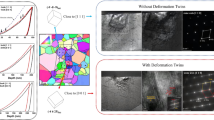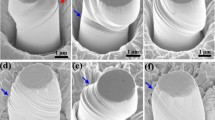Abstract
The aim of the present study is to investigate the nucleation and growth behavior of twin region around yield point of polycrystalline pure Ti under deformation. Firstly, we prepare commercial polycrystalline pure Ti plate, and investigate the microstructure and pole figures using an Electron Backscatter Diffraction Patterns device. Secondly, tensile specimens are cut out from 0°, 30°, 45° and 90° relative to plate rolling direction. Then, we measure the macroscopic stress–strain curve, local strain distribution and nucleation and growth of twin region arising in specimens under uniaxial tensile loading. Results show the anisotropic characteristics in those behaviors. Those could be related to c axis in hcp lattice. However, detailed anisotropic mechanism may have something to do with several interactions between slips and twins arising in its body. It is also understood that the avalanche behavior of twin region nucleation occurs as a result of larger twin region formation, with inhomogeneous small twin region nucleation in transient process. Finally, we could suppose the bridge mechanism of deformation behaviors from macroscale to microscale for polycrystalline pure Ti under deformation.











Similar content being viewed by others
References
Dimiduk DM, Woodward C, LeSar R, Uchic MD (2006) Scale-free intermittent flow in crystal plasticity. Science 312(5777):1188–1190
Weiss J, Marsan D (2003) Three-dimensional mapping of dislocation avalanches: clustering and space/time coupling. Science 299(5603):89–92
Richeton T, Weiss J, Louchet F (2005) Breakdown of avalanche critical behaviour in polycrystalline plasticity. Nat Mater 4(6):465–469
Richeton T, Weiss J, Louchet F (2005) Dislocation avalanches: Role of temperature, grain size and strain hardening. Acta Mater 53(16):4463–4471
Miguel MC, Vespignani A, Zapperi S, Weiss J, Grasso JR (2001) Intermittent dislocation flow in viscoplastic deformation. Nature 410(6829):667–671
Weiss J, Grasso J (1997) Acoustic emission in single crystals of ice. J Phys Chem B 101(32):6113–6117
Richeton T, Dobron P, Chmelik F, Jerome W, Louchet F (2006) On the critical character of plasticity in metallic single crystals. Mater Sci Eng A 424(1–2):190–195
Dimiduk DM, Uchic MD, Parthasarathy TA (2005) Size-affected single-slip behavior of pure nickel microcrystals. Acta Mater 53(15):4065–4077
Uchic MD, Dimiduk DA (2005) A methodology to investigate size scale effects in crystalline plasticity using uniaxial compression testing. Mater Sci Eng A 400:268–278
Jakobsen B, Poulsen HF, Lienert U, Almer J, Shastri SD, Sorensen HO, Gundlach C, Pantleon W (2006) Formation and subdivision of deformation structures during plastic deformation. Science 312(5775):889–892
Akhtar A (1975) Basal slip and twinning in a-titanium single crystals. Metall Trans A 6A:1105–1113
Paton N (1970) Plastic deformation of titanium at elevated temperatures. Metall Trans A 1(10):2839–2847
Yoo MH (1981) Slip, twinning and fracture in hexagonal close-packed metals. Metall Trans A 12(3):409–418
Mullins S, Patchett BM (1981) Deformation microstructures in titanium sheet-metal. Metall Trans A 12(5):853–863
Battaini M, Pereloma EV, Davies CHJ (2007) Orientation effect on mechanical properties of commercially pure titanium at room temperature. Metall Trans A 38A(2):276–285
Christian JW, Mahajan S (1995) Deformation Twinning. Prog Mater Sci 39(1–2):1–157
Yoneyama S, Morimoto Y (2003) Accurate displacement measurement by correlation of colored random patterns. JSME Int J Series A - Solid Mech Mater Eng 46(2):178–184
Yoneyama S, Morimoto Y, Takashi M (2006) Automatic evaluation of mixed-mode stress intensity factors utilizing digital image correlation. Strain 42(1):21–29
Yoneyama S, Kitagawa A, Iwata S, Tani K, Kikuta H (2007) Bridge deflection measurement using digital image correlation. Exp Tech 31(1):34–40
Murasawa G, Yoneyama S, Sakuma T (2007) Nucleation, bifurcation and propagation of local deformation arising in NiTi shape memory alloy. Smart Mater Struct 16(1):160–167
Murasawa G, Kitamura K, Yoneyama S, Miyazaki S, Miyata K, Nishioka A, Koda T (2009) Macroscopic stress-strain curve, local strain band behavior and the texture of NiTi thin sheets. Smart Mater Struc 18(5):055003
Pollock A (1973) Acoustic emission-2: acoustic emission amplitudes. Non-Destr Test 6(5):264–269
Agnew SR, Yoo MH, Tome CN (2001) Application of texture simulation to understanding mechanical behavior of Mg and solid solution alloys containing Li or Y. Acta Mater 49(20):4277–4289
Agnew SR, Duygulu O (2005) Plastic anisotropy and the role of non-basal slip in magnesium alloy AZ31B. Int J Plasticity 21(6):1161–1193
Proust G, Tome CN, Kaschner GC (2007) Modeling texture, twinning and hardening evolution during deformation of hexagonal materials. Acta Mater 55(6):2137–2148
Proust G, Tome CN, Jain A, Agnew SR (2009) Modeling the effect of twinning and detwinning during strain-path changes of magnesium alloy AZ31. Int J Plasticity 25(5):861–880
Kalidindi S (2004) A crystal plasticity framework for deformation twinning in continuum scale simulation of eng. materials: fundamentals-microstructures-process applications. In: Raabe D, Roters F, Barlat F, Chen LQ (eds) Ch27:543–560
Staroselsky A, Anand L (2003) A constitutive model for hcp materials deforming by slip and twinning: application to magnesium alloy AZ31B. Int J Plast 19(10):1843–1864
Bulatov VV, Argon AS (1994) A stochastic-model for continuum elastoplastic behavior. 3. Plasticity in ordered versus disordered solids. Model Simul Mater Sci 2(2):203–222
Toronchuk JP (1977) Acoustic emission during twinning of zinc single crystals. Mater Eval 35(10):51–53
Ananthakrishna G, Noronha SJ, Fressengeas C, Kubin LP (1999) Crossover from chaotic to self-organized critical dynamics in jerky flow of single crystals. Phys Rev E 60(5):5455–5462
Bak P, Tang C, Wiesenfeld K (1987) Self-organized criticality—an explanation Of 1/f Noise. Phys Rev Lett 59(4):381–384
Bak P, Tang C, Wiesenfeld K (1988) Self-organized criticality. Phys Rev A 38(1):364–374
Acknowledgements
The author would like to express my deep gratitude to gratitude to Prof. Mitsutoshi Kuroda (Yamagata University, Japan), Associate Prof. Takuya Uehara (Yamagata University, Japan) and Assistant Prof. Kengo Yoshida (Yamagata University, Japan) for fruitfully discussing about present study. Also, The author would like to express my deep gratitude to Dr. Tadaaki Satake (Yamagata University, Japan), Mr. Masato Obata and Mr. Naotaka Tobita for the help of experiments.
Author information
Authors and Affiliations
Corresponding author
Rights and permissions
About this article
Cite this article
Murasawa, G., Morimoto, T. & Yoneyama, S. Nucleation and Growth Behavior of Twin Region Around Yield Point of Polycrystalline Pure Ti. Exp Mech 52, 503–512 (2012). https://doi.org/10.1007/s11340-011-9508-x
Received:
Accepted:
Published:
Issue Date:
DOI: https://doi.org/10.1007/s11340-011-9508-x




